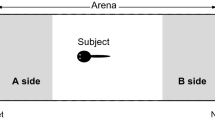Summary
The ontogeny of sibling recognition behavior was studied in the laboratory in tadpoles of the western toad (Bufo boreas boreas) to test the hypothesis that Bufo tadpoles associate with siblings and to compare this behavior with two species of anurans previously studied. Tadpoles reared exclusively with sibs demonstrated a preference to associate with sibs over non-sibs both early and late in development but tadpoles reared with sibs and non-sibs (mixed rearing groups) exhibited no preference. Larvae that developed a preference for sibs after being reared with them for 75 days lost this preference following exposure to a mixed group for 2 to 6 days. Additionally, larvae reared in a mixed group did not develop a preference for the familiar mixed group nor was a preference exhibited by individual larvae that were reared exclusively with 5 non-sibs. These results suggest that larvae learn by prior association to discriminate sibs from non-sibs and that preferences are rapidly modifiable following exposure to non-sibs. However, the latter two experiments suggest that social preferences are not totally labile and are not based entirely on familiarity. Field observations of larval activity, aggregation behavior, and dispersal patterns in B. boreas indicate that tadpoles mix with non-sibs from early larval stages throughout development. Because even short term exposure to nonsibs resulted in a loss of sib preference in our experiments, we suggest that a ‘kin selection’ interpretation of B. boreas aggregation behavior is not parsimonious. Results differ with those of other studies of sib recognition in larval anurans.
Similar content being viewed by others
References
Alexander RD (1979) Darwinism and human affairs. Univ of Washington Press, Seattle
Beiswenger RE (1972) Aggregative behavior of tadpoles of the American toad, Bufo americanus, in Michigan. PhD thesis, Univ of Michigan, Ann Arbor
Beiswenger RE (1975) Structure and function in aggregations of tadpoles of the American toad, Bufo americanus. Herpetologica 31:222–233
Beiswenger RE (1977) Diel patterns of aggregative behavior in tadpoles of Bufo americanus in relation to light and temperature. Ecology 58:98–108
Bekoff M (1981) Mammalian sibling interactions: Genes, facilitative environments, and the coefficient of familiarity. In: Gubernick D, Klopfer PH (eds) Parental care in mammals. Plenum, New York
Bekoff M (1983) The development of behavior from evolutionary and ecological perspectives: towards a generic social biology. In: Gollin ES (ed) The evolution of adaptive skills: comparative and ontogenetic approaches, Academic Press, New York London
Bertram BCR (1978) Living in groups: predators and prey. In: Krebs JR, Davies NB (eds) Behavioural ecology: an evolutionary approach. Sinauer Assoc, Sunderland, MA, pp 64–96
Blaustein AR, O'Hara RK (1981) Genetic control for sibling recognition? Nature 290:246–248
Blaustein AR, O'Hara RK (1982) Kin recognition in Rana cascadae tadpoles: maternal and paternal effects. Anim Behav (in press)
Buckle GR, Greenberg L (1981) Nestmate recognition in sweat bees (Lasioglossum zephyrum): does an individual recognize its own odour or only odours of its nestmates? Anim Behav 29:802–809
Fisher RA (1930) The genetical theory of natural selection. Clarendon Press, Oxford
Gosner KL (1960) A simplified table for staging anuran embryos and larvae with notes on identification. Herpetologica 16:183–190
Greenberg L (1979) Genetic component of bee odor in kin recognition. Science 206:1095–1097
Hamilton WD (1964) The genetical evolution of social behaviour, I, II. J Theoret Biol 7:1–51
Hamilton WD (1971) Geometry for the selfish herd. J Theoret Biol 31:295–311
Holmes WG, Sherman PW (1982) The ontogeny of kin recognition in two species of ground squirrels. Am Zool (in press)
Kukuk PF, Breed MD, Sobti A, Bell WJ (1977) The contributions of kinship and conditioning to nest recognition and colony member recognition in a primitively eusocial bee, Lasioglossum zephyrum (Hymenoptera: Halictidae). Behav Ecol Sociobiol 2:319–327
Kurland JA (1980) Kin selection theory: a review and selective bibliography. Ethol Sociobiol 1:255–274
Linsenmair KE (1972) Die Bedeutung familienspezifischer Abzeichen für den Familienzusammenhalt bei der sozialen Wüstenassel Hemilepistus reaumuri Audouin und Savigny (Crustacea, Isopoda, Oniscoidea). Z Tierpsychol 31:131–162
O'Hara RK (1981) Habitat selection behavior in three species of anuran larvae: environmental cues, ontogeny, and adaptive significance. PhD thesis, Oregon State Univ, Corvallis
O'Hara RK, Blaustein AR (1981) An investigation of sibling recognition in Rana cascadae tadpoles. Anim Behav 29:1121–1126
Porter RH, Wyrick M (1979) Sibling recognition in spiny mice (Acomys cahirinus): influence of age and isolation. Anim Behav 27:761–766
Porter RH, Wyrick M, Pankey J (1978) Sibling recognition in spiny mice (Acomys cahirinus). Behav Ecol Sociobiol 3:61–68
Porter RH, Tepper VJ, White DM (1981) Experiential influences on the development of huddling preferences and “sibling” recognition in spiny mice. Dev Psychobiol 14:375–382
Rothstein SI, Barash DP (1982) Gene conflicts and the concepts of outlaw and sheriff alleles. J Social Biol Structures (in press)
Salzen EA, Cornell JM (1968) Self perception and species recognition in birds. Behaviour 30:44–65
Samollow PB (1979) Dynamics of enzyme polymorphism in a natural population of the boreal toad, Bufo boreas boreas Baird and Girard: evidence of natural selection via differential mortality in early life history stages. PhD thesis, Oregon State Univ, Corvallis
Samollow PB (1980) Selective mortality and reproduction in a natural population of Bufo boreas. Evolution 34:18–39
Stebbins RC (1951) Amphibians of western North America. Univ of California Press, Berkeley
Waldman B (1981) Sibling recognition in toad tadpoles: the role of experience. Z Tierpsychol 56:341–358
Waldman B, Adler K (1979) Toad tadpoles associate preferentially with siblings. Nature 282:611–613
Wassersug RJ, (1973) Aspects of social behavior in anuran larvae. In: Vial JL (ed) Evolutionary biology of the anurans. Univ of Missouri Press, Columbia, pp 273–297
Wilbur HM (1977) Density-dependent aspects of growth and metamorphosis in Bufo americanus. Ecology 58:196–200
Wilson EO (1975) Sociobiology: the new synthesis. Belknap Harvard, Cambridge, MA
Wu HMH, Holmes WG, Medina SR, Sackett GP (1980) Kin preference in infant Macaca nemestrina. Nature 285:225–227
Author information
Authors and Affiliations
Rights and permissions
About this article
Cite this article
O'Hara, R.K., Blaustein, A.R. Kin preference behavior in Bufo boreas tadpoles. Behav Ecol Sociobiol 11, 43–49 (1982). https://doi.org/10.1007/BF00297665
Received:
Accepted:
Issue Date:
DOI: https://doi.org/10.1007/BF00297665




